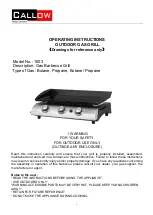
4
Gas Cylinder Information
Gas Cylinder Safety Information
• This appliance is designed to be used with a gas
cylinder not exceeding (Australia 9KG) (USA 20lbs)
capacity (Refer to AS:2030.)
USA: The Gas cylinder must be constructed and marked
in accordance with specifications for LP Gas Cylinders
of the: (USA) U.S. Dept. of Transportation (DOT) or
the National Standard of Canada, CAN/CSA - B339,
Cylinders, Spheres or Tubes for the transportation of
dangerous goods.
• The gas cylinder supply valve must be turned off
when the appliance is not in use.
• Gas cylinders must be stored outdoors, out of reach
of children and must not be stored in a building,
garage or any other enclosed area.
• The gas cylinder used must incorporate a safety
collar to protect the valve assembly.
Important:
• When disconnecting and removing the gas cylinder
for the purpose of refilling, always observe the
following procedure.
• Ensure that all gas control valves on the appliance
and the gas cylinder are turned off before
disconnecting the gas line from the cylinder.
• Do not smoke or use a naked flame near the
appliance or gas cylinder while disconnecting the
gas line between the appliance and gas cylinder.
• Remove the gas cylinder from the enclosure before
disconnecting the gas line from the appliance.
• Tighten all connections before placing the gas
cylinder back in its enclosure.
• The gas leak testing procedure should be conducted
every time the gas cylinder is refilled and reconnected
to the appliance before using the appliance.
Regulator Connection
1. Check that all control knobs are in the ‘Off’ position.
2. Make sure the cylinder valve is off.
3. Remove the protective cap from the cylinder if
present.
4. Leak test the connection with a soapy water solution.
(See Gas Leak Testing Procedure)
Hose and Regulator replacement must be a genuine
BeefEater part specified for this appliance. This is
obtainable from your nearest BeefEater stockist.
Gas Leak Test Procedure
Never use a naked flame to check for gas leaks. Always
use the following procedure to check for gas leaks.
1. In a small container, mix up a solution of water and
detergent or soap. Mix the solution well.
2. For LPG or Natural Gas: Make sure that the gas
supply valve on the gas cylinder or shut off valve on
the gas supply line is turned on.
3. Make sure that the gas control valves on the
appliance are all turned off.
4. Using a brush or spray bottle apply the solution to the
gas line and each join in the gas line. (See fig. 1)
5. Bubbling of the solution will indicate that there is a
leak present.
6. Re-tighten or re-seal any joints that are leaking.
7. If a leak persists then contact your distributor or the
manufacturer for assistance.
Important
Always check the
gas label on the
appliance to ensure
that you have
the correct gas
configuration
Forming bubbles
indicate that a leak is
present
Fig. 1
Fig. 2
Fig. 3


































